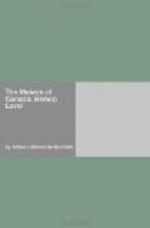as to martyrdom, for your affection for me would incline
you to desire it for me, but I mean as to other outrages.
I see no reason for apprehension; all that I hear does
not dismay me.’ When she was cast out upon
the snow, together with her sisters, in the middle
of a winter’s night, by reason of a conflagration
which devoured her convent, her first act was to prevail
upon her companions to kneel with her to thank God
for having preserved their lives, though He despoiled
them of all that they possessed in the world.
Her strong and noble soul seemed to rise naturally
above the misfortunes which assailed the growing colony.
Trusting fully to God through the most violent storms,
she continued to busy herself calmly with her work,
as if nothing in the world had been able to move her.
At a moment when many feared that the French would
be forced to leave the country, Mother of the Incarnation,
in spite of her advanced age, began to study the language
of the Hurons in order to make herself useful to the
young girls of this tribe. Ever tranquil, she
did not allow herself to be carried away by enthusiasm
or stayed by fear. ’We imagine sometimes,’
she wrote to her former superior at Tours, ’that
a certain passing inclination is a vocation; no, events
show the contrary. In our momentary enthusiasms
we think more of ourselves than of the object we face,
and so we see that when this enthusiasm is once past,
our tendencies and inclinations remain on the ordinary
plane of life.’ Built on such a foundation,
her piety was solid, sincere and truly enlightened.
In perusing her writings, we are astonished at finding
in them a clearness of thought, a correctness of style,
and a firmness of judgment which give us a lofty idea
of this really superior woman. Clever in handling
the brush as well as the pen, capable of directing
the work of building as well as domestic labour, she
combined, according to the opinion of her contemporaries,
all the qualities of the strong woman of whom the
Holy Scriptures give us so fine a portrait. She
was entrusted with all the business of the convent.
She wrote a prodigious number of letters, she learned
the two mother tongues of the country, the Algonquin
and the Huron, and composed for the use of her sisters,
a sacred history in Algonquin, a catechism in Huron,
an Iroquois catechism and dictionary, and a dictionary,
catechism and collection of prayers in the Algonquin
language.”
CHAPTER VII
THE SMALLER SEMINARY
The smaller seminary, founded by the Bishop of Petraea
in 1668, for youths destined to the ecclesiastical
life, justified the expectations of its founder, and
witnessed an ever increasing influx of students.
On the day of its inauguration, October 9th, there
were only as yet eight French pupils and six Huron
children. For lack of teachers the young neophytes,
placed under the guidance of directors connected with
the seminary, attended during the first years the
classes of the Jesuit Fathers. Their special
costume was a blue cloak, confined by a belt.
At this period the College of the Jesuits contained
already some sixty resident scholars, and what proves
to us that serious studies were here pursued is that
several scholars are quoted in the memoirs as having
successfully defended in the presence of the highest
authorities of the colony theses on physics and philosophy.




